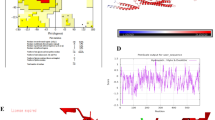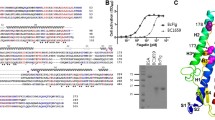Abstract
Recombinant flagellin (FliC) has shown low efficacy in purification because of inclusion bodies formation and aggregation. We hypothesized preserving TLR5 binding site of FliC and removing some amino acids could be responsible for aggregation and solubility improvement. Hence, a bioinformatics study was performed to find hotspots in aggregate formation. Protein modeling was carried out by SWISS-MODEL and I-TASSER servers and models were compared by MATRAS server and Chimera 1.11.2. Gene modification was carried out based on bioinformatics studies. Genes, (truncated modified fliC (tmFliC) and full-length fliC (flFliC)), were cloned and expressed in pET-21a vector. Protein purification was carried out using HIS-Tag method. Proliferation assay and also induction of IL-8 in HEK293 cells were performed to confirm bioactivity function of tmFliC. Bioinformatics results showed that partial deletion of C-terminus may increase solubility without unfavorable effect on TLR5 recognition. Also, model comparison showed that this protein may preserve 3D structure. In addition, GlobPlot server demonstrated that tmFliC formed its globular domains which were important in TLR5 recognition. As we expected, high purification efficacy for tmFliC compared with flFliC was also obtained in experimental studies and a proper function for tmFliC was observed. The tmFliC enhanced cell proliferation in HEK293 cells compare with control after 24 h. Also, IL-8 level was increased with stimulation by tmFliC after 24 h. In conclusion, reducing hydrophobicity in C-terminus and deleting necessary amino acids for filament formation may increase protein solubility.








Similar content being viewed by others
References
Ramos, H. C., Rumbo, M., & Sirard, J. C. (2004). Bacterial flagellins: Mediators of pathogenicity and host immune responses in mucosa. Trends in Microbiology, 12(11), 509–517.
Bao, W., Wang, Y., Fu, Y., Jia, X., Li, J., Vangan, N., Bao, L., Hao, H., & Wang, Z. (2015) mTORC1 regulates flagellin-induced inflammatory response in macrophages. PLoS ONE, 10(5), e0125910.
Gewirtz, A. T., Yu, Y., Krishna, U. S., Israel, D. A., Lyons, S. L., & Peek, R. M. (2004). Helicobacter pylori flagellin evades toll-like receptor 5-mediated innate immunity. Journal of Infectious Diseases, 189(10), 1914–1920.
Taherkhani, R., Farshadpour, F., Makvandi, M., & Samarbafzadeh, A. R. (2014) Cloning of FliC gene from Salmonella typhimurium in the expression vector pVAX1 and evaluation of its expression in eukaryotic cells. Jundishapur Journal of Microbiology, 7(11), e12351.
Faezi, S., Bahrmand, A. R., Mahdavi, M., Siadat, S. D., Nikokar, I., Sardari, S., & Holder, I. A. (2016). High yield overexpression, refolding, purification and characterization of Pseudomonas aeruginosa type B-flagellin: An improved method without sonication. International Journal of Molecular and Cellular Medicine, 5(1), 37.
Sormanni, P., Amery, L., Ekizoglou, S., Vendruscolo, M., & Popovic, B. (2017). Rapid and accurate in silico solubility screening of a monoclonal antibody library. Scientific Reports, 7(1), 8200.
Ducat, T., Declerck, N., Gostan, T., Kochoyan, M., & Demene, H. (2006). Rapid determination of protein solubility and stability conditions for NMR studies using incomplete factorial design. Journal of Biomolecular NMR, 34(3), 137–151.
Trevino, S. R., Scholtz, J. M., & Pace, C. N. (2008). Measuring and increasing protein solubility. Journal of Pharmaceutical Sciences, 97(10), 4155–4166.
Agostini, F., Cirillo, D., Livi, C. M., Ponti, D. R., Tartaglia, G. G. (2014). ccSOL omics: A webserver for solubility prediction of endogenous and heterologous expression in Escherichia coli. Bioinformatics, 30(20), 2975–2977.
Smialowski, P., Doose, G., Torkler, P., Kaufmann, S., & Frishman, D. (2012). PROSO II—A new method for protein solubility prediction. The FEBS Journal, 279(12), 2192–2200.
Altschul, S. F., Madden, T. L., Schäffer, A. A., Zhang, J., Zhang, Z., Miller, W., & Lipman, D. J. (1997). Gapped BLAST and PSI-BLAST: A new generation of protein database search programs. Nucleic Acids Research, 25(17), 3389–3402.
Shander, A., Gromiha, M., Fawareh, H., & Sarai, A. (2004). ASA view: Solvent accessibility graphics for proteins. Bioinformatics, 51, 51.
Linding, R., Russell, R. B., Neduva, V., & Gibson, T. J. (2003). GlobPlot: Exploring protein sequences for globularity and disorder. Nucleic Acids Research, 31(13), 3701–3708.
Gasteiger, E., Hoogland, C., Gattiker, A., Wilkins, M. R., Appel, R. D., & Bairoch, A. (2005) Protein identification and analysis tools on the ExPASy server. Totowa, NJ: Humana Press.
Biasini, M., Bienert, S., Waterhouse, A., Arnold, K., Studer, G., Schmidt, T., Kiefer, F., Cassarino, T. G., Bertoni, M., Bordoli, L., & Schwede, T. (2014). SWISS-MODEL: Modelling protein tertiary and quaternary structure using evolutionary information. Nucleic Acids Research, 42, 252–258.
Zhang, Y. (2008). I-TASSER server for protein 3D structure prediction. BMC Bioinformatics, 9(1), 40.
Kawabata, T. (2003). MATRAS: A program for protein 3D structure comparison. Nucleic Acids Research, 31(13), 3367–3369.
Pettersen, E. F., Goddard, T. D., Huang, C. C., Couchm, G. S., Greenblatt, D. M., Meng, E. C., & Ferrin, T. E. (2004). UCSF Chimera—A visualization system for exploratory research and analysis. Journal of Computational Chemistry, 25(13), 1605–1612.
de Zoete, M. R., Keestra, A. M., Wagenaar, J. A., & van Putten, J. P. (2010). Reconstitution of a functional Toll-like receptor 5 binding site in Campylobacter jejuni Flagellin. Journal of Biological Chemistry, 285(16), 12149–12158.
Molloy, M. J., Bouladoux, N., & Belkaid, Y. (2012). Intestinal microbiota: Shaping local and systemic immune responses. Seminars in Immunology, 24(1), 58–66.
Skountzou, I., del Pilar Martin, M., Wang, B., Ye, L., Koutsonanos, D., Weldon, W., Jacob, J., & Compans, R. W. (2010). Salmonella flagellins are potent adjuvants for intranasally administered whole inactivated influenza vaccine. Vaccine, 28(24), 4103–4112.
Ahmadian, G., Ghahroudi, M. A., Rastgoo, N., & Mianji, G. R. (2005). Bacterial expression and functional characterization of a naturally occurring exon 6-less preprochymosin cDNA. Iranian Journal of Biotechnology, 3(1), 16–25.
Ikai, A. (1980). Thermostability and aliphatic index of globular proteins. The Journal of Biochemistry, 88(6), 1895–1898.
Ozin, J. A., Claret, L., Auvray, F., & Hughes, C. (2003). The FliS chaperone selectively binds the disordered flagellin C-terminal D0 domain central to polymerization. FEMS Microbiology Letters, 219, 219–224.
Forstnerič, V., Ivičak-Kocjan, K., Plaper, T., Jerala, R., & Benčina, M. (2017) The role of the C-terminal D0 domain of flagellin in activation of Toll like receptor 5. PLoS Pathogens, 13(8), e1006574.
Smith, K. D., Andersen-Nissen, E., Hayashi, F., Strobe, K., Bergman, M. A., Barrett, S. L. R., Cookson, B. T., & Aderem, A. (2003). Toll-like receptor 5 recognizes a conserved site on flagellin required for protofilament formation and bacterial motility. Nature Immunology, 4, 1247.
Vonderviszt, F., Shin-Ichi, A., & Keiichi, N. (1991). Role of the disordered terminal regions of Flagellin in filament formation and stability. Journal of Molecular Biology, 221(4), 1461–1474.
Wan, W., Wille, H., Stöhr, J., Kendall, A., Bian, W., McDonald, M., … Stubbs, G. (2015). Structural studies of truncated forms of the prion protein PrP. Biophysical Journal, 108(6), 1548–1554.
Rigi, G., Beyranvand, P., Ghaedmohammadi, S., Heidarpanah, S., Akbari Noghabi, K., & Ahmadian, G. (2015) Comparison of the extracellular full-length and truncated recombinant protein A production in Escherichia coli BL21 (DE3). Journal of Paramedical Sciences, 6(3), 2008–4978.
Strub, C., Alies, C., Lougarre, A., Ladurantie, C., Czaplicki, J., & Fournier, D. (2004). Mutation of exposed hydrophobic amino acids to arginine to increase protein stability. BMC Biochemistry, 5, 9.
Gupta, S. K., Deb, R., Gaikwad, S., Saravanan, R., Mohan, C. M., & Dey, S. (2013). Recombinant flagellin and its cross-talk with lipopolysaccharide—Effect on pooled chicken peripheral blood mononuclear cells. Research in Veterinary Science, 95, 930–935.
Kogut, M. H., Iqbal, M., He, H., Philbin, V., Kaiser, P., & Smith, A. (2005). Expression and function of Toll-like receptors in chicken heterophils. Developmental and Comparative Immunology, 29, 791–807.
Acknowledgements
The authors would like to show their gratitude to Dr. Majid Esmaelizad from Razi Vaccine and Serum Research Institute.
Author information
Authors and Affiliations
Corresponding author
Ethics declarations
Conflict of interest
The authors confirm that they have no conflicts of interest.
Rights and permissions
About this article
Cite this article
Khani, Mh., Bagheri, M., Dehghanian, A. et al. Effect of C-Terminus Modification in Salmonella typhimurium FliC on Protein Purification Efficacy and Bioactivity. Mol Biotechnol 61, 12–19 (2019). https://doi.org/10.1007/s12033-018-0135-y
Published:
Issue Date:
DOI: https://doi.org/10.1007/s12033-018-0135-y




